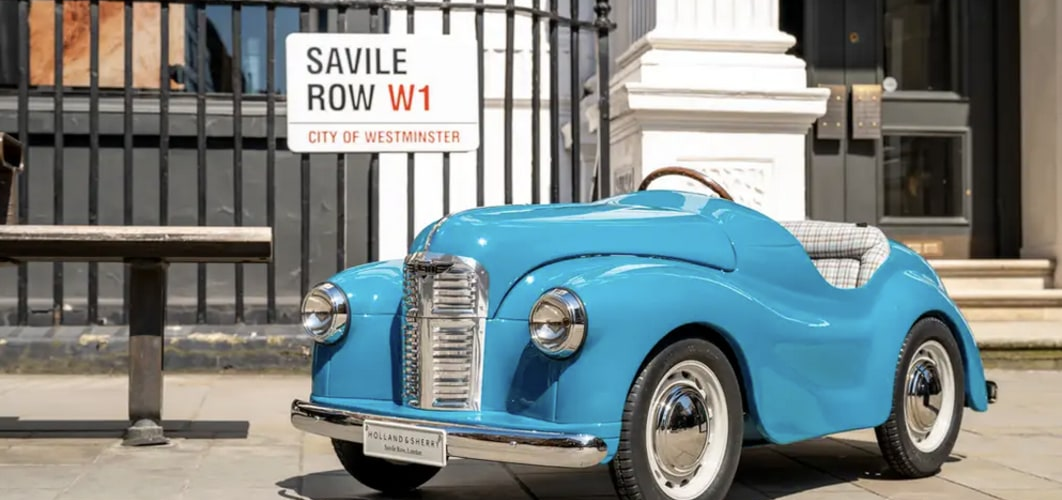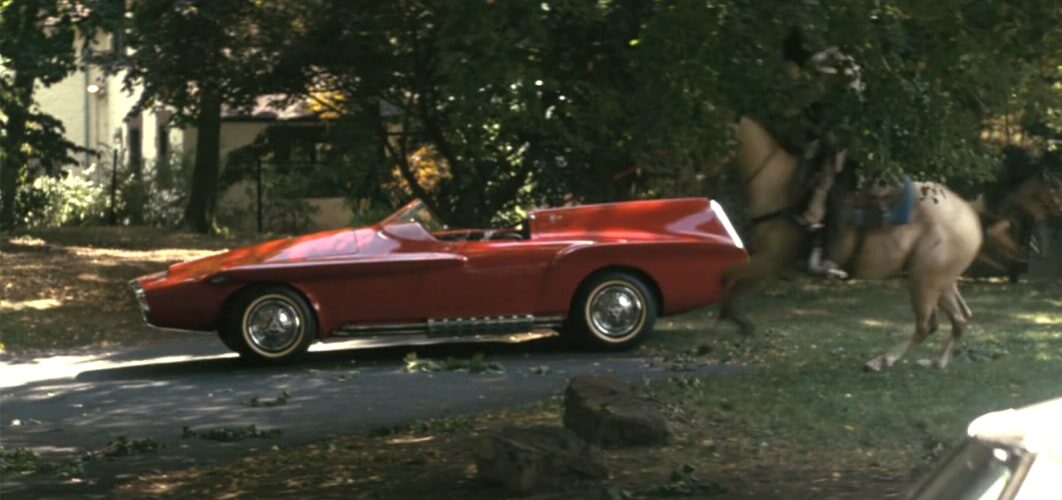Update: Reporter for Hagerty confirms the actual car was used. The text has been updated to reflect this.
Amazon MGM Studios aired the first season of its new TV show “Fallout.” It’s based on the long-running video game series that takes place in an alternative universe based on 1950s ideas of futurism, with it all leading up to all-out thermonuclear war and the aftermath. So to fit the look, any scenes that take place before the nuclear war feature ’50s dress, political ideology, and, of course, automobiles. Most of the cars in the show are actual production vehicles from the time period. One of the main characters, Cooper Howard, drives a gorgeous yellow Kaiser Darrin, and there’s even a scene that showcases the car’s super cool sliding pocket doors. A Messerschmitt tandem bubble car also makes an appearance (and there are lookalikes that you can find in the game). But the most interesting and unique car shows up in the first episode, and amazingly, it’s hidden in the background of various shots.
It doesn’t take long to spot it, as it appears in the first few minutes of the show. These scenes start at a birthday party just before the bombs drop, and it’s most visible in the shot at top when Howard takes off on horseback with his daughter in search of safety. They race past a big bright red roadster of some sort, with gleaming side-exit exhaust and a rear fin reminiscent of some period race cars. That vehicle isn’t made specifically for the show. It’s the Plymouth XNR concept from 1960, and apparently it’s the real deal, as discovered by a reporter for Hagerty.
The actual 1960 Plymouth XNR concept has a heaping helping of hypnotizing history. It was designed by Virgil Exner (hence the XNR name), who worked at Pontiac, Studebaker, and most famously, Chrysler Corporation. He started at Chrysler with concept cars, and the first production cars credited to him were the “Forward Look” models that included the original C-300 that would eventually inspire the 2005 Chrysler 300.
The styling is seriously wild. As we mentioned, it has asymmetric cues from race cars of the time, but amplified with the hood scoop that leads into a long rising cowl. The exhaust only comes out on the driver side, and then the rear has a sort of chrome star tying the rear fin in with the pseudo bumper. The radical looking fenders also appeared on the original 1960 Valiant, which was quickly placed under the Plymouth brand, with Dodge getting its own version called Lancer. The XNR even uses the Valiant’s chassis according to Motor Trend (which has an excellent, detailed look at the car from the sadly defunct Motor Trend Classic magazine).
On top of the wild looks from designer royalty, the XNR was actually a fully functional car. It had a 170-cubic-inch (or about 2.8L in metric displacement) 250-horsepower inline-six with a three-speed manual transmission and rear-wheel drive. And while it looks as though it only has a driver seat, there is a passenger seat hidden under a removable body panel. It also featured independent front suspension with torsion springs and a live rear axle with leaf springs. Those rear leaf springs were even tidily fit to the curve of the rear body (or probably more likely, the body fit to the springs)



When Chrysler was done with the car, it began a wild journey, first going to Italy and Carrozzeria Ghia, the company that built the body. It eventually went to multiple other owners, including at one point the Shah of Iran. It was eventually found by Karim Edde, who discovered it in Lebanon in the ’80s and had to move it about to keep it safe as civil war broke out. It was then restored by RM Restorations, part of what’s now the RM Sotheby’s auction house, in the late 2000s. Following its restoration, it was shown at Pebble Beach in 2011 where it won the Gran Turismo award, which meant it was added as a drivable car in the video game series including the latest “Gran Turismo 7.” It’s actually quite fun to drive, especially with the high-revving engine. The game shows redline as being just shy of 8,000 rpm.
And that brings us to today, where the car has appeared in “Fallout.” When we first wrote this, we tried to get some info about whether the car involved was the actual XNR, or a replica made by by Gotham Garage, the custom car shop featured in Netflix’s “Car Masters: Rust to Riches.” That replica is now at the Petersen Museum in Los Angeles, and the PR contact for the museum confirmed the replica wasn’t used. HotCars reported that Gotham Garage was looking at building another replica a while back, which added another possible car to the mix. We also reached out to Amazon for details but never got a reply. But a friend and reporter for Hagerty found a contact that could confirm the actual car was used.
So now, on top of an already fascinating existence, the XNR gets to add TV star to its resume. Pretty sweet if you ask us.
Source link





